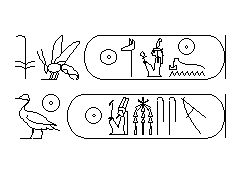
Faraone della XIX dinastia, figlio di Sethi I. Fu uno dei faraoni piu' importanti e fra quelli che regnarono piu' a lungo, in questo caso per ben 67 anni. Durante il suo regno continuo' la guerra contro gli ittiti iniziata da suo padre, che culmino' nella battaglia di Kadesh, dove Ramses evito' la sconfitta solo grazie al suo coraggio. Alla fine l'armata egizia fu costretta a ritirarsi, ma pochi anni dopo Ramses fu in grado di riconquistare parte del territorio perduto. Subito dopo firmo' un trattato di pace con gli ittiti. In Egitto, Ramses inizio' una grande quantita' di lavori edilizi, fra cui degli ampliamenti dei templi di Luxor e Karnak, e il suo tempio funerario, il ramesseum. Ramses costrui' anche in Nubia, per esempio i templi di Abu Simbel. La residenza reale venne spostata in una nuova citta' nel Delta, chiamata Per-Ramessu ('casa di Ramses'), fondata da Sethi I. Statue, obelischi e colonne vennero trasportate li' da altre citta'. Qui vennero costruiti dei templi per gli dei nazionali Amon, Ra e Ptah, senza pero' dimenticare gli altri dei, per esempio Seth di Avaris. Come dio delle terre conquistate in Asia, quest'ultimo era identificato con Baal e connesso con la dea Anat. Nel frattempo, Tebe rimase il centro religioso come citta' del dio Amon. I suoi gran sacerdoti iniziarono ad acquistare sempre maggiore influenza come possessori di potere religioso, il che avrebbe portato alla costituzione dello 'stato' del dio Amon. La piu' importante consorte di Ramses II fu la regina Nefertari, che possiede una famosa tomba nella Valle delle Regine. Molti dei suoi numerosi figli furono seppelliti in una tomba collettiva nella Valle dei Re, scoperta nella meta' degli anni '90. Sappiamo che il figlio di Ramses Khaemwaset, gran sacerdote di Ptah a Menfi, costrui' l'ultimo luogo di sepoltura di numerosi tori Api nel Serapeum a Saqqara (dove forse era seppellito egli stesso).